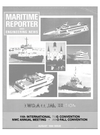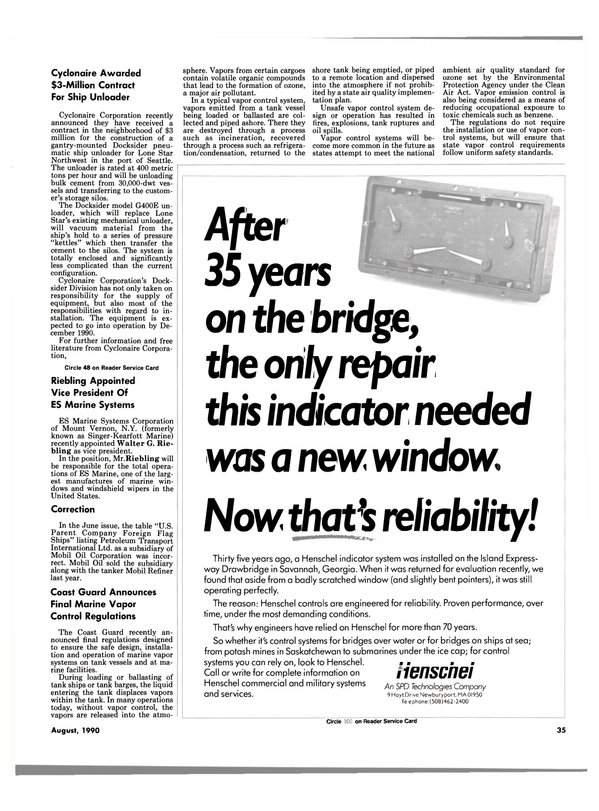
Coast Guard Announces Final Marine Vapor Control Regulations
The Coast Guard recently announced final regulations designed to ensure the safe design, installation and operation of marine vapor systems on tank vessels and at marine facilities.
During loading or ballasting of tank ships or tank barges, the liquid entering the tank displaces vapors within the tank. In many operations today, without vapor control, the vapors are released into the atmo- sphere. Vapors from certain cargoes contain volatile organic compounds that lead to the formation of ozone, a major air pollutant.
In a typical vapor control system, vapors emitted from a tank vessel being loaded or ballasted are collected and piped ashore. There they are destroyed through a process such as incineration, recovered through a process such as refrigeration/ condensation, returned to the shore tank being emptied, or piped to a remote location and dispersed into the atmosphere if not prohibited by a state air quality implementation plan.
Unsafe vapor control system design or operation has resulted in fires, explosions, tank ruptures and oil spills.
Vapor control systems will become more common in the future as states attempt to meet the national ambient air quality standard for ozone set by the Environmental Protection Agency under the Clean Air Act. Vapor emission control is also being considered as a means of reducing occupational exposure to toxic chemicals such as benzene.
The regulations do not require the installation or use of vapor control systems, but will ensure that state vapor control requirements follow uniform safety standards.
Read Coast Guard Announces Final Marine Vapor Control Regulations in Pdf, Flash or Html5 edition of August 1990 Maritime Reporter
Other stories from August 1990 issue
Content
- Largest Aluminum Charter Yacht In North America Delivered By Aluminum Boats page: 8
- Trinity Marine Group Licensed To Build Westamarin Aluminum Catamarans In United States page: 8
- Directions In Design Awarded Casino Boat Interior Design Contract page: 9
- Art Anderson Associates Expands Professional Staff page: 9
- Furuno Introduces New Shipboard Communications System page: 10
- Tidewater Adds 11 Boats To Domestic Fleet page: 10
- 'Reborn' Meridian Emerges From $55-Million Reconstruction At Lloyd Werft-Bremerhaven page: 11
- Cummins-Powered Aluminum Boat Delivered By Argo Marine For Logging Operation page: 12
- Service Marine To Build Dinner/Excursion Boat For Chicago Firm page: 12
- ASNE Symposium 1990 Set For Biloxi, Miss., September 27-29 page: 13
- Comsat Develops New High-Speed Data Service —Literature Available page: 13
- MSI Combines Emergency Medical Training Program With Shiphandling Course page: 14
- New Platinum Series Watermakers Introduced By Matrix Desalination page: 15
- ETA-Pilot Fuel Saving System Now Marketed Worldwide By SSPA page: 16
- New Designs And Developments From Munson Manufacturing In Oil Spill Response Vessels page: 18
- SeaArk Marine To Supply 19 Oil Spill Recovery Boats To State Of Florida page: 20
- Campbell Chain Develops New Process To Extend Chain Life page: 20
- IMO Double CIG Pumps Offer Increased Flow Rates At Lower Installed Cost page: 22
- Chantiers De L'Atlantique To Build Two Passenger Ships For Kloster Cruise page: 23
- Bird-Johnson Awarded MCM Propeller Contract page: 23
- National Waterway Conference To Hold Annual Meeting In New Orleans page: 24
- Do increased Tax Revenues' Translate Into Higher Waterways User Taxes? page: 25
- The Who's Who In NWC page: 25
- NWC: Promoting Sound & Far-Sighted Waterways Policies page: 26
- New Firefighting Foam Offered By Ansul For Flammable Liquid Fires page: 27
- Freeport Shipbuilding Begins Construction On Trend-Setting Carambat Megayacht/Houseboat page: 28
- Call For Papers Issued For 'Marine Computers '91' Symposium In Boston page: 29
- 11th International Tug Convention And International Marine Salvage Symposium page: 30
- ASSESSMENT OF THE U.S. MARINE MARKET page: 32
- Magellan Offers Low-Cost Portable GPS Receivers —Literature Available page: 33
- ASRY Dry Dock Occupancy Near 90 Percent During First Quarter page: 34
- Wartsila Diesel Announces Recent Personnel Appointments page: 34
- Coast Guard Announces Final Marine Vapor Control Regulations page: 35
- A New Course For AWO's Shipyard Conference page: 36
- Homeport Marine Delivers 'Eastern Wind/ First Of Two U.S.-Flag Fish Tenders page: 37
- NABRICO Delivers 260-Foot RO/RO Barges For Boston Harbor Project page: 37
- Furuno Introduces New FR/FAR-2800 Big Ship Radar/ARPA Line page: 40
- NuFlex Offers Composite Vapor Hoses For Transfer Operations page: 41
- Conferees A g r e e On Scheduling Of Tanker Double-Hull Phase-In page: 41
- New York Shipyard Reports Busy Vessel Repair Schedule page: 42
- $200-Million Japanese Liner Fitted With Magnavox Advanced Multi-Channel SatCom System page: 44
- Henschel Named Exclusive U.S. Licensee For Speed Measuring Units page: 45
- AMERICA'S SMALL- AND MEDIUM-SIZED YARDS REFERENCE GUIDE AND REVIEW page: 48
- Marine Gears Delivers Haley Units For Three Vessels At Main Iron page: 54
- COMSAT Acquires Interest In MMS page: 55
- ZF Announces Improvements In Four Marine Transmissions page: 56


